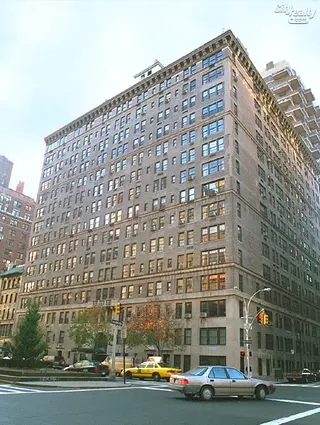 Carter Horsley
Carter HorsleyDec 23, 2011
Carter's Review
With its double-height entrance and large, arched window providing glimpses of its large, landscaped garden courtyard, 1088 Park Avenue on the southwest corner at 89th Street is one of the boulevard's few apartment houses with a grand canopied entry.
It was designed by Mott B. Schmidt for Robert J. Cuddihy.
The 15-story building was erected in 1925 and has 84 cooperative apartments.
Bottom Line
A very handsome pre-war building wrapped, in two sections, around a large garden and which has abundant “light and air” because of the large mid-block plazas of the Park Regis at 50 East 89th Street and 60 East 88th Street.
Description
The gray-brick, neo-Classical building has a three-story limestone base with an arched, two-story-high, rusticated, canopied entrance that provides glimpses of its large vaulted lobby and the very large landscaped garden courtyard.
The multi-paned, arched window is repeated on the sides of the two-story high rooftop watertank enclosure.
There is a keystone head above the canopy and three arched windows beneath a balustrade balcony as part of the handsome entrance surround.
The building has a bandcourse above the third floor and stringcourses above the 4th, 7th, 11th and 14th floors. It has a handsome cornice.
The building has some protruding air-conditioners.
The building wraps around its garden except for the northwest corner at 88th Street and Park Avenue where there are two 5-story buildings.
In 1980, the building, to its great credit, banned the installation of "picture" windows because of esthetic concerns, according to a January 22, 1995 article by Christopher Gray in The New York Times about the building ending a three-year moratorium on window replacements. The building's board authorized the installation of new windows that had muntins dividing panes like the building's original windows, but about a third of the residents decided not to upgrade and to keep their old wooden windows.
"From the outside, the form of the new windows closely matches the original ones, especially from sidewalk distance. But you can tell by the glass: The modern windows are a single, perfect sheet under the muntins, with shadowy reflections caused by the double glazing. The glass in the old windows has gentle ripples, like a stream eddy, and each pane reflects the light at a slightly different angle. The wood itself has a soft, varied quality that metal cannot match. For a sophisticated design like that of 1088, the only truly hurtful change on the outside is the choice of color. The original woodwork on this and most other 1920's apartment houses was painted buff, or cream, or white, in sympathy with the masonry skin. The co-op has chosen the aluminum industry's standard brown and is repainting the surviving wooden windows the same color," Gray observed.
From the courtyard’s brick terrace, the “Carnegie Hill Architectural Guide” noted, “the arched glass doorways of the lobby hallways are reminiscent of a Roman aqueduct,” adding that “at the far end of the courtyard an Italian Mannerist fountain and loggia built above a shallow rectangular pool form the focal point of this hidden city garden.”
Amenities
The building has a doorman, a concierge, a gym, a bicycle room and private storage. It also permits pets.
Apartments
Penthouse 16F is a duplex with a 12-foot-long entry foyer on the lower level that leads to a 19-foot-long gallery that opens a 17-foot-long library and a 26-foot-long living room with fireplace that is next to an 18-foot-long dining room next to a 16-foot-long kitchen on the lower level, which also has three bedrooms. The upper level has two more bedrooms and 1,500-square-foot terrace.
Apartment 10A us a three-bedroom unit that has a 13-foot-long entry foyer that leads to a 27-foot-long living room with a wood-burning fireplace that opens onto a 20-foot-long dining room next to a 14-footlong pantry and a 14-foot-long eat-in kitchen and laundry and 10-foot-long staff room. The apartment also has a 18-foot-long library.
Apartment 10C us a two-bedroom unit with a long entry foyer that leads to a 15-foot-long gallery that opens onto a 27-foot-long living room with a fireplace and a 20-foot-long dining room next to a 10-foot-long pantry, a 12-foot-long kitchen and a 13–foot-long maid’s room.
Apartment 6B is a two-bedroom unit that has a 15-foot-long entrance gallery that leads to a 27-foot-long living with wood-burning fireplace and a 20-foot-long dining room next to a 10-foot-long pantry and a 12-foot-long kitchen and a 14-foot-long maid’s room.
History
The building was developed by Robert J. Cuddihy, publisher of The Literary Digest, whose circulation in 1927 of 1.5 million was second only to the Saturday Evening Post, according to James Trager, the author of 'Park Avenue, Street of Dreams,' (Atheneum, 1990).
"Cuddihy is said to have financed construction of 1088 Park because, as a Roman Catholic, he was unable to get into another Fifth or Park Avenue co-op. Whether this is true or not, Cuddihy and his son, H. Lester, a friend of Robert Moses, engaged Mott B. Schmidt as architect....its central garden courtyard, with its fountains and Italian loggia, was Lester's idea....It has...always been considered an elegant address, a favorite of families with children," Trager wrote, adding that one of its early residents was the managing editor of The New York Times.

- Co-op built in 1925
- Located in Carnegie Hill
- 84 total apartments 84 total apartments
- 10 recent sales ($700K to $5.3M)
- Doorman
- Pets Allowed
 6sqft delivers the latest on real estate, architecture, and design, straight from New York City.
6sqft delivers the latest on real estate, architecture, and design, straight from New York City.
